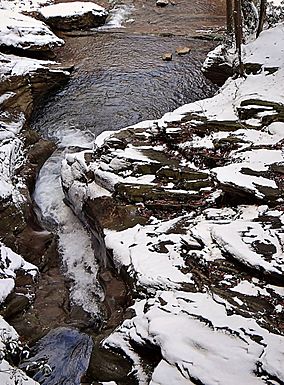Seven Tubs Recreation Area facts for kids
Quick facts for kids Seven Tubs Recreation Area |
|
|---|---|

Seven Tubs in winter
|
|
| Location | Wilkes-Barre, Luzerne, Pennsylvania, United States |
| Area | 537 acres (217 ha) |
| Governing body | Luzerne County Parks and Recreation Department |
The Seven Tubs Recreation Area is a cool place to visit in Luzerne County, Pennsylvania. It's owned by the state and is open for everyone to enjoy.
Imagine water flowing for thousands of years! That's how the "tubs" were made. Over 12,000 years ago, melting ice from glaciers carved smooth, round holes in the hard rock. These holes are called potholes.
This special spot is part of a 537-acre recreation area. It's located in the mountains of Pennsylvania. You can find it about 4 miles south of downtown Wilkes-Barre. It's a popular place for hikers because it's easy to get to and has trails that are great for beginners.
Contents
How the Tubs Formed: A Look at Geology
The Ice Age was a time when huge sheets of ice, called glaciers, covered much of the Earth. These glaciers helped shape the land we see today. They are also responsible for creating the amazing tubs!
When the ice slowly melted over a very long time, it created huge amounts of flowing water. This powerful water carved out the rocks in the area. The tubs are mostly made from a type of rock called gritty sandstone. Other common rocks nearby include limestone, shale, and coal.
A stream called Wheelbarrow Run flows right through the tubs. It eventually joins a bigger stream called Laurel Run. Both of these streams have cut deep gorges and canyons into the land. This area is known as Whirlpool Valley. It's a fantastic place for hikers to explore.
Amazing Wildlife: Plants and Animals
Seven Tubs is home to many different kinds of plants and animals. It's a great place to see nature up close!
Flora: Beautiful Plants and Trees
You'll find many colorful wildflowers growing around the tubs and in the nearby forests. The northeast part of the United States has many types of wildflowers, and Seven Tubs is no different.
Here are some of the wildflowers you might spot:
- Pearly everlasting (Anaphalis margaritacea)
- Wild lettuce (Prenanthes alba)
- Jack-in-the-pulpit (Arisaema triphyllum)
- Closed gentian (Gentiana andrewsii)
- Pink lady's slipper (Cypripedium acaule)
- Self-heal (Prunella vulgaris)
- Small round-leaved orchis (Orchis rotundifolia)
- Harebell (Campanula rotundifolia)
Other plants that grow well here include trailing arbutus (Epigaea repens), mountain laurel (Kalmia latifolia), sheep laurel (Kalmia angustifolia), and blueberry bushes.
The forests around the tubs are very dense, meaning there are lots of trees! You can see many different kinds, such as:
- Hemlock trees
- Yellow, gray, and black birch trees
- White and red chestnuts
- Bear oaks
- Tulip trees
- Red and striped maples
- Big-tooth and quaking aspens
- American sycamores
- American beeches
- White ash
- Slippery elm
- Sassafras
- White gum
- Witch-hazel
- Flowering dogwood
- Staghorn sumac
- White, red, and pitch pines
Fauna: Amazing Animals and Birds
If you love watching birds, Seven Tubs is a great place to visit! You might even see some birds that are becoming rare in this part of Pennsylvania. The types of birds you see can change depending on the time of year.
Some birds you might spot include:
- Whippoorwill
- Saw-whet owl
- Barred owl
- Eastern towhee
- Yellow-shafted flicker
- Brown thrasher
- Eastern wood pewee
You might also see game birds like wild turkey and ruffed grouse.
Besides birds, many different mammals live in their natural homes here. You might see animals of all sizes! Some common animals include:
- Deer
- Long-tailed weasel
- Red and gray foxes
- Opossum
- Brown bat
One animal to be extra careful around is the black bear. Black bears are usually shy, but it's important to be cautious if you see one. They are the smallest of the three types of bears in the northeast, but they are still wild animals. If you ever see a black bear, it's best to speak calmly and slowly back away. Bear sightings are not super common, but they do live in the area.
Fun Activities at Seven Tubs
There's a path that follows the tubs up the mountain. Some parts of the path are even friendly for wheelchairs. In a few spots, there are stairs to help you go down the hills.
The many trees provide lots of shade, and the cool water flowing through the tubs helps keep the area cooler. This is great on a warm day!
When you're hiking, be careful of loose rocks and slippery moss. They can make it easy to lose your footing. There aren't many signs warning about these dangers, so always be cautious as you explore the tubs.
Soon, Seven Tubs will be the starting point for the D&L Trail. This trail is 165 miles long and is great for walking, running, or biking!
Nearby Parks to Explore
There are many other state parks close to Seven Tubs in northeast Pennsylvania. Some of them include:
While many of these parks share similar features, each one also has its own unique things to see and do. This means you can have a different nature adventure at each park!


